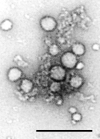A detergent-based assay for the detection of promiscuous inhibitors
- PMID: 17191086
- PMCID: PMC1544377
- DOI: 10.1038/nprot.2006.77
A detergent-based assay for the detection of promiscuous inhibitors
Abstract
At micromolar concentrations, many small molecules self-associate into colloidal aggregates that non-specifically inhibit enzymes and other proteins. Here we describe a protocol for identifying aggregate-based inhibitors and distinguishing them from small molecules that inhibit via specific mechanisms. As a convenient proxy for promiscuous, aggregate-based inhibition, we monitor inhibition of beta-lactamase in the absence and presence of detergent. Inhibition that is attenuated in the presence of detergent is characteristic of an aggregate-based mechanism. In the 96-well-format assay described here, about 200 molecules can be tested, in duplicate, per hour for detergent-dependent sensitivity. Furthermore, we also describe simple experiments that can offer additional confirmation of aggregate-based inhibition.
Figures

References
-
- Hajduk PJ, Huth JR, Fesik SW. Druggability indices for protein targets derived from NMR-based screening data. J. Med. Chem. 2005;48:2518–2525. - PubMed
-
- Rishton GM. Reactive compounds and in vitro false positives in HTS. Drug Discov. Today. 1997;2:382–384.
-
- Walters WP, Namchuk M. Designing screens: how to make your hits a hit. Nat. Rev. Drug Discov. 2003;2:259–266. - PubMed
-
- Feng BY, et al. High-throughput assays for promiscuous inhibitors. Nat. Chem. Biol. 2005;1:146–148. - PubMed
Publication types
MeSH terms
Substances
Grants and funding
LinkOut - more resources
Full Text Sources
Other Literature Sources
Research Materials

